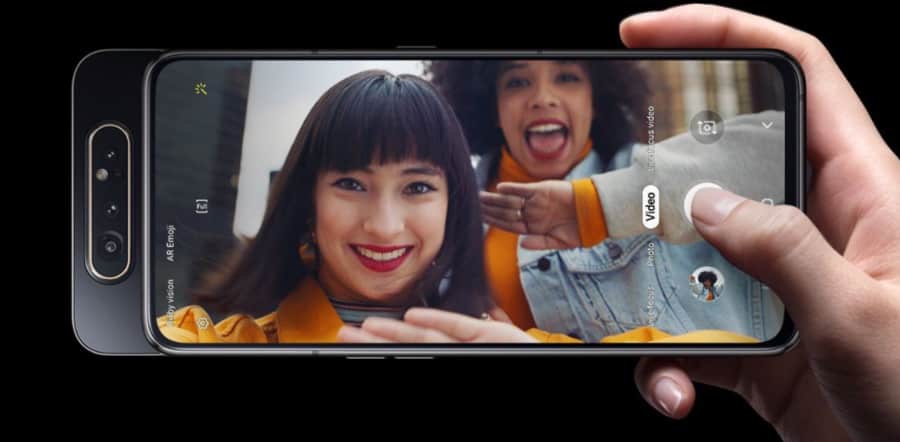
Above: Samsung’s new slider design for its A80 camera system. Photo courtesy Samsung.
BitDepth#1193 for April 18, 2019
Last week, Samsung introduced its new line of lifestyle focused smartphones, the A series line of devices.
According to the company’s CEO, DJ Koh, the new line of devices are “made for the era of live.”
The presentation in Bangkok emphasised a youth market and featured a largely incomprehensible performance by that country’s popular girl group, Black/Pink.
“[This is] A generation that loves to create authentic, unfiltered content and needs to share their experiences with friends and the world,” Koh said.
The new line of devices is six strong, starting with the A10 and peaking with the A80.
The product line is built around four critical tools for creating and sharing media; powerful video creation tools, device security based on the company’s Knox encryption, processors fast enough to handle creating on the device and a long lasting battery.
In even the cellar position A10, the company offers an octacore CPU chip, recent generation GPU and a 3,400 MaH battery.
The penthouse level A80 ramps up to a much faster CPU and GPU chip, with a 3,700 MaH battery capable of fast charging at 25W.
The A80 quadruples the A10’s RAM from 2GB to 8 and includes a standard camera capable of capturing 48MP images and video at 2160p.
Curiously enough, the A70, launched last week with availability from April 29, has superior specifications on paper, capturing 32MP images, 2160p video and ships with a 4,800 MaH battery.
The devices take advantage of Samsung’s Intelligent Camera system, which takes automation of camera making one step further by examining captures for blur, shake and closed eyes.
The premium smartphones, the A80, A70 and A50, include the depth camera that gives the S10 series its computational depth of field chops, creating an illusion of much greater focus control than smartphone cameras are optically capable of.
All the devices take advantage of Samsung’s Intelligent Camera system, which takes automation of camera making one step further by examining captures for blur, shake and closed eyes, warning snappers that they might want to take another photo to be sure.
The 48MP sensor on the A80’s main camera is likely to be the new Sony IMX586 1.2 inch sensor for smartphones, though it isn’t the first camera to capture big files.
In 2013, Nokia shipped the Lumia 1020, which captured 41MP files, winning the beleagured camera maker some much needed attention.
Huawei offered the P20Pro with a 40MP sensor in April 2018.
Historically, packing that many pixel sites into a small chip hasn’t resulted in state of the art imagery, but the A80’s capabilities are still to be put to the test.
At the very least, the 8,000 x 6,000 pixel capture makes a longer lens redundant. A crop of a full resolution capture for web use would make the standard 27mm lens capable of a reach equivalent to a 400mm lens.
The A80’s smaller battery may be the result of its big new hardware innovation, a triple lens rear camera array that pops up and swivels to face the smartphone’s user raising the stakes of the selfie game.
It’s a clever bit of slider engineering that eliminates any notches on the front of the screen.
It’s another step forward in Samsung’s steady march to an all-screen face for its top of the line smartphones, which have had their retaining bands shrunk at the edges, seen a steady attrition of the black display frame and introduced a curved glass edge Infinity Display that enhances the illusion of image-to-the-edge display technology.
Samsung may be selling these new features as supportive of an active, connected lifestyle, but it’s also clearly testing clever innovations in the A80 to see how they fly in the market. Expect to see them deployed in its other premium devices if they prove popular.




